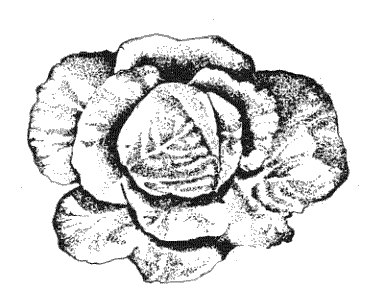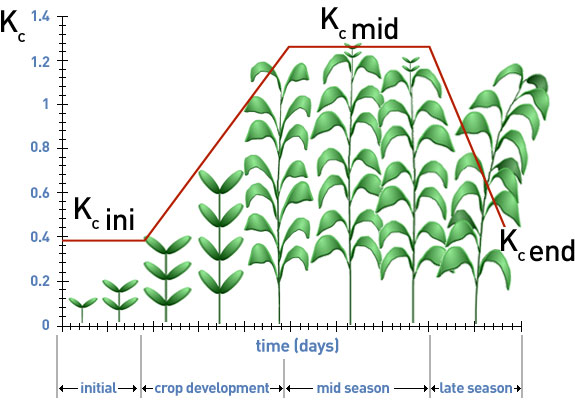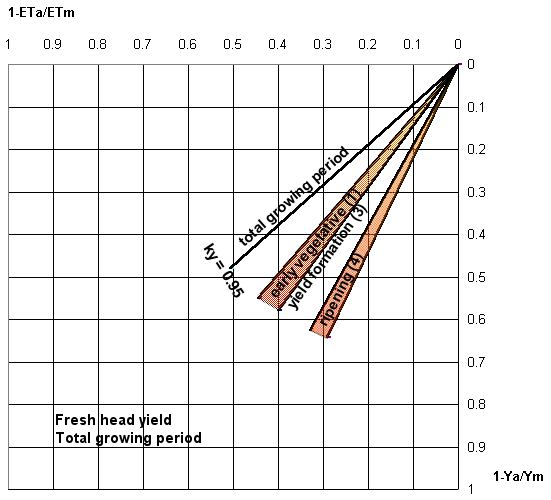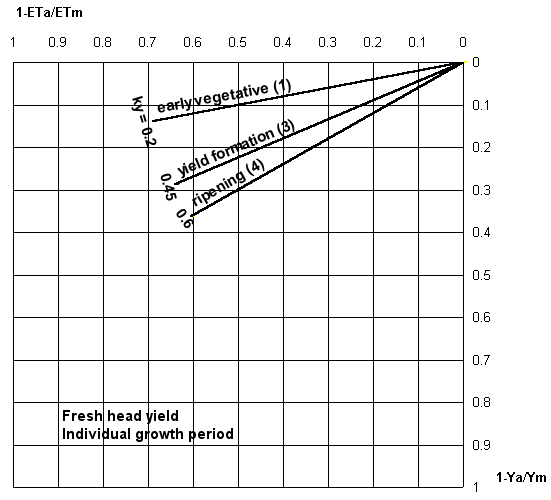Cabbage
This section presents information on water relations and water management of cabbage and provides links to other sources of information.
Crop Description and Climate
Crop Description and Climate
Cabbage (Brassica oleracea var. capitata) originates from the south and western coast of Europe. Annual world production is about 55 million tons of fresh heads from 2.6 million ha (FAOSTAT, 2001).
For high production the crop requires a cool, humid climate. The length of the total growing period varies between 90 (spring-sown) and 200 (autumn-sown) days, depending on climate, variety and planting date, but for good production the growing period is about 120 to 140 days. Most varieties can withstand a short period of frost of -6°C, some down to -l0°C. Long periods (30 to 60 days) of -5°C are harmful. The plants with leaves smaller than 3 cm will survive long periods of low temperature but when the leaves are 5 to 7 cm, the plant will initiate a seed stalk and this leads to a poor quality yield. Optimum growth occurs at a mean daily temperature of about 17°C with daily mean maximum of 24°C and minimum of 10°C. Mean relative humidity should be in the range of 60 to 90 percent.
Generally, the heavier loam soils are more suited to cabbage production. Under high rainfall conditions, sandy or sandy loam soils are preferable because of improved drainage. The fertilizer requirements are high: 100 to 150 kg/ha N, 50 to 65 kg/ha P and 100 to 130 kg/ha K.
Cabbage is moderately sensitive to soil salinity. Yield decrease due to soil salinity at different levels of ECe is: 0% at ECe 1.8, 10% at 2.8, 25% at 4.4, 50% at 7.0 and 100% at ECe 12.0 mmhos/cm.
Row spacing is dependent on the size of heads required for markets or between 0.3 and 0.5 m for heads of 1 to 1.5 kg each and 0.5 and 0.9 m for heads up to 3 kg each. An optimum production can be reached with a plant density in the range of 30000 to 40000 plants/ha. Planting can be by direct seeding with a seed rate of 3 kg/ha, or by transplanting from open field beds and from cold frames which are used to protect the crop from cold during germination and early plant development.
Cabbage is characterized by slow development during the first half of the growing period, which may be 50 days for early maturing and up to 100 for autumn-sown, late maturing varieties (establishment and vegetative periods; 0 and 1). During the following periods (yield formation and ripening periods, 3 and 4) the plant doubles its weight approximately every 9 days over a total period of 50 days. In the beginning of the yield formation period (3), head formation starts, followed by a sudden decrease in the rate of leaf-unfolding. Eventually, leaf unfolding ceases completely, whilst leaf initiation continues. This results in the formation of a restrictive skin by the oldest folded leaves within which younger leaves continue to grow until the firm, mature head is produced during the ripening period of 10 to 20 days (4). Depending on variety, the head can be pointed or round, green or red, smooth or crinkled. Crop rotation of at least 3 years is recommended to combat soil-borne diseases.
Full-grown Cabbage

The graph below depicts the crop stages of cabbage, and the table summarises the main crop coefficients used for water management.

Stages of | Plant | Region | |||||
|---|---|---|---|---|---|---|---|
Crop | Initial | Crop | Mid-season | Late | Total |
| |
Stage length, | 40 | 60 | 50 | 15 | 165 | September | Calf. Desert, USA |
Depletion | 0.4 | >> | 0.4 | 0.4 | - | ||
Root Depth, m | 0.25 | >> | >> | 0.5 | - | ||
Crop Coefficient,Kc | 0.7 | >> | 1.05 | 0.95 | - |
|
|
Yield Response | 0.2 | - | 0.45 | 0.6 | 0.95 |
|
|
Water Requirements
Water Requirements
Water requirements vary from 380 to 500 mm depending on climate and length of growing season. The crop transpiration increases during the crop growing period with a peak toward the end of the season. In relation to the reference evapotranspiration (ETo), the crop coefficient (kc) for cabbage is: during the initial stage 0.4-0.5 (20 to 30 days); the crop development stage 0.7-0.8 (30 to 35 days); the mid season stage 0.95-1.1 (20 to 30 days), the late season stage 0.9-1.0 (10 to 20 days); and at harvest 0.8-0.95.
Water Supply And Crop Yield
Water Supply And Crop Yield
The relationships between relative yield decrease (1 - Ya/Ym) and relative evapotranspiration deficit for the total growing period are shown in the figure below.

This figure shows the relationships between relative yield decrease (1 - Ya/Ym) and relative evapotranspiration deficit for the individual growth periods.

The relationships between relative yield decrease and relative evapotranspiration deficit based on interpreted information are given in Figure 12. The response to water supply increases with development of the crop. During the slow development in the vegetative period (1), the crop yield is little affected by water deficit. Once rapid growth during yield formation period (3) is reached, the yield depressing effect of limited water supply becomes increasingly pronounced until the end of the growing period. Under conditions of limited water supply, a high total production is obtained by extending the area and partially meeting crop water requirements rather than by meeting full crop water requirements over a limited area.
Water Uptake
Water Uptake
Cabbage has an extensive, shallow root system. The majority of the roots are found in the top 0.4 to 0.5 m of the soil with a rapid decrease in root density with depth. Normally 100 percent of the water is extracted from this layer (D = 0.4-0.5 m). Under conditions when ETm = 5 to 6 mm/day, the rate of water uptake by the crop starts to reduce when the available soil water has been depleted by about 35 percent (p = 0.35).
Irrigation Scheduling
Irrigation Scheduling
Depending on climate, crop development and soil type, the frequency of irrigation varies between 3 and 12 days. If available water supply is limited, early irrigations should not be practised unless these can be continued until the end of the crop growing period. Water savings should preferably be made in the beginning of the crop growing period.
Irrigation Methods
Irrigation Methods
Furrow, sprinkler and trickle irrigation are used. However, the acreage under subsoil irrigation, which gives generally better results, is -increasing. With subsoil irrigation, the depth of the water table is maintained between 0.3 and 0.7 m in fine, sandy loam and between 0.7 and 1. 1 m in loam soils.
Yield
Yield
Under rainfed conditions, yields of 25 to 35 ton/ha fresh heads are normal, with a maximum of about 50 ton/ha when sprayed and well-fertilized. Under ideal climatic conditions and good irrigation and crop management, yields can be as high as 85 ton/ha. The utilization efficiency for harvested yield (Ey) for heads is about 12 to 20 kg/m3.
The average water content of cabbage heads is about 90 percent, with a high vitamin B, C and calcium and phosphorous content. Smaller heads of poor quality are produced when the crop is grown under limited water supply, particularly during the later part of the growing period.
